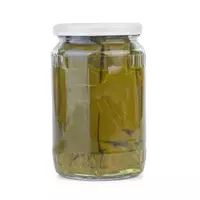Canned grape leaves

Grapes or as the fruit name Vitis sounds in Latin is a plant belonging to the Vinogradov family. Human grapes have been consumed by humans since time immemorial. In addition, wine, juices, as well as food concentrates are made from grape fruits. Due to its distinctive useful properties, as well as consumer characteristics, grapes quickly went on the list of some of the most important food products. Currently, there are an incredible number of varieties, species and subspecies of the plant.
It is worth noting that grapes are not only delicious, but also incredibly healthy fruit. The most striking illustrations of the benefits of grapes for human health can be provided by certain branches of medicine called ampelotherapy or enotherapy. These two effective therapies that help in the treatment and prevention of certain diseases are entirely based on the use of grapes and wine as the main medicine.
In addition to grape fruits, grape leaves are eaten. Moreover, there are two main varieties of the product - fresh and canned grape leaves. As a rule, canned grape leaves are used as a replacement for fresh or cabbage leaves. Canned grape leaves are most popular in the Turkish, Bulgarian, Vietnamese, Arab and Armenian culinary traditions.
Some dishes, such as dolma, simply cannot be prepared without the use of fresh or canned grape leaves. Since grape leaves are so important for the culinary tradition of some states, they are harvested for future use using the canning process. The full taste palette of canned grape leaves is revealed in combination with lamb. For dishes made of canned grape leaves, legumes, such as beans, lentils, chickpeas or Turkish peas, are often served as a side dish.
To make canned grape leaves, the leaves of white grape varieties are used. At the same time, grape leaves are harvested during the flowering period of the vine. Grape leaves can be harvested in various ways, for example, dry, freeze, salt or marinate the product. Since the composition of grape leaves is enriched with various useful compounds of natural origin and vitamins of groups A, B, C, E, K and PP during preservation, most of the above substances are transferred to the composition of canned grape leaves.
This means that canned grape leaves are not only a tasty, but also a healthy food for the human body. Young leaves of white grape varieties are selected for conservation. It is important to prevent damage to natural material. Grape leaves are washed, piled into dense stacks, and then poured with brine, which is made from salt and water. In addition, you can twist pre-washed and dried grape leaves into rolls of 5 pieces each and place in cans under a capron lid.
93 kCal canned grape leaves
Energy value of canned grape leaves (Ratio of proteins, fats, carbohydrates - ju):
Proteins: 5.6 g (~ 22 kCal)
Fats: 2.12 g (~ 19 kCal)
Carbohydrates: 6.31 g (~ 25 kCal)
Energy ratio (bj | y): 24% | 21% | 27%
 Español
Español Français
Français Português
Português Русский
Русский 简体中文
简体中文 繁體中文
繁體中文 日本語
日本語 한국어
한국어 العربية
العربية Türkçe
Türkçe Қазақ
Қазақ Deutsch
Deutsch Italiano
Italiano Українська
Українська
